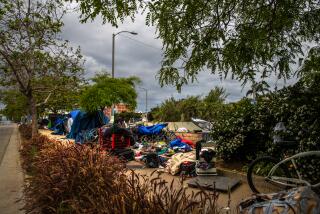Pavilion’s Days Appear Numbered
- Share via
They bolted the rusty doors shut 15 years ago and ever since, critics say, the Venice Pavilion has been a crumbling eyesore, a rat-infested monument to public neglect and unfulfilled intentions.
Now, though, after much haggling over the future of the quirky complex, city officials are poised to demolish the pavilion as part of a $15-million plan to spruce up Venice Beach for the Democratic National Convention in August.
The oval-shaped beachside building, once known for its evening concerts and lively community programs, now mostly hosts transient squatters. It was the scene of a rock-throwing confrontation in February when police tried to break up a large crowd attending a hip-hop concert.
Even as a handful of local activists mount a last-ditch effort to save the brick building, it appears more than likely that the city of Los Angeles will soon receive its final demolition permit from the California Coastal Commission. Planners for the commission recently recommended that the pavilion be razed and replaced by park and beach space--a move that would open up a wide view of the sea from the boardwalk.
The commission is scheduled to decide the matter Jan. 11.
The pavilion, a stark structure that looms over Venice Beach at Ocean Front Walk and Windward Avenue, was built in 1959 as a combined recreation center, open-air amphitheater and enclosed theater. During its early days, the pavilion was a popular venue for concerts, plays, public meetings, children’s and senior citizen activity programs, and art workshops.
But some of the pavilion’s biggest supporters and inhabitants say they have resigned themselves to its destruction.
“As far as the city’s concerned this place has already been torn down,” said Ron Parks, a homeless man who has camped in the Pavilion’s shuffleboard court for more than a decade. “To them, everything you see here is just an illusion.”
Public interest in the pavilion began to wane in the 1970s, and the city closed it off to the public in 1984 due to lack of use. Several well-publicized attempts to revive the pavilion by the city and the community group Venice Arts Mecca failed.
Since its closure, the building has been shared by the homeless and the Venice Beach detail of the Los Angeles Police Department. Officers have long complained that their basement substation there lacks adequate lighting and is plagued by rats, leaks and other general decay. Recently, a beach officer was shocked and injured by a faulty electrical connection.
One city official said the substation conjured up images of interrogation rooms in some far-off prisoner-of-war camp. Plans have been made to move the substation to a mobile office nearby until a permanent replacement is built as part of the new park.
Critics say the pavilion was built with too many mistakes. It has no parking spaces, is too close to the booming surf for concert acoustics and suffers heavy damage from damp weather.
“This place should have been torn down a decade ago,” said Rick Feibusch, a Venice neighborhood activist and longtime pavilion opponent. “It was poorly conceived when it was built. People stopped using the place because it’s just worthless.”
The city has proposed replacing the brick pavilion with beach sand, a children’s playground, a landscaped park, a public sculpture and a single-story police substation and park maintenance office.
The new park area would retain some of the Venice Pavilion’s character--most notably its world-famous graffiti pit, a concrete picnic area that has been covered entirely with spray-paint. Two of the pit’s walls would remain standing, as would five picnic tables and a barbecue.
Those who want to preserve the pavilion say it was meant to be a resource for low-income residents and should be put to that use once again.
Eighty-year-old Venice activist Pearl White has filed an appeal with the Coastal Commission demanding that the demolition permit be denied. She says the city should renovate the building and offer children’s day camps, free entertainment and, in the process, jobs for local residents.
White insists that such programs would benefit poor black and Latino families in such Venice neighborhoods as Oakwood. She says the city’s failure to renovate the pavilion amounts to racism and is contributing to the gentrification of Venice.
“We’re going to do whatever it takes to keep that old nasty building,” White said. “We want to clean it up and use it to help create jobs and provide services.”
City officials say it would cost about $2 million to renovate the pavilion but only $400,000 to demolish it. They also deny White’s claim that the replacement project discriminates against low-income families.
“Right now it’s this huge chunk of property which the public--low income, middle income or high income--has no access to,” said Michael Bonin, a spokesman for Councilwoman Ruth Galanter. “The whole idea of what we’re doing is to give this area back to the people.”
More to Read
Sign up for Essential California
The most important California stories and recommendations in your inbox every morning.
You may occasionally receive promotional content from the Los Angeles Times.














